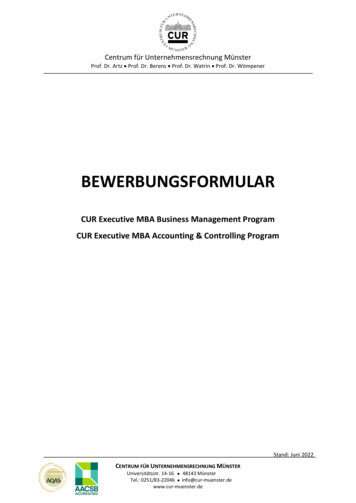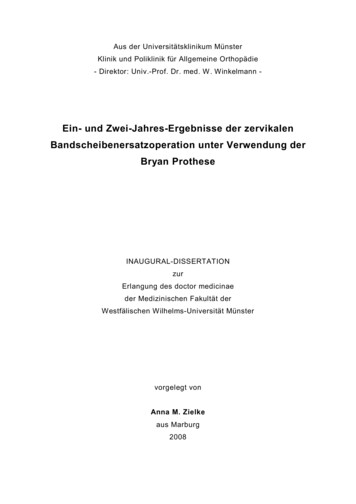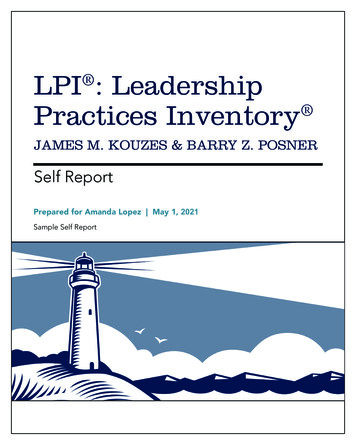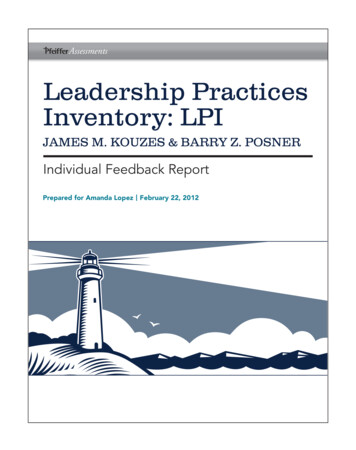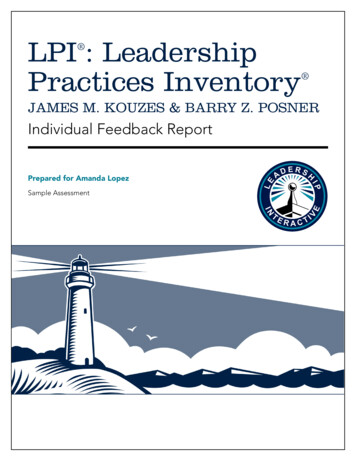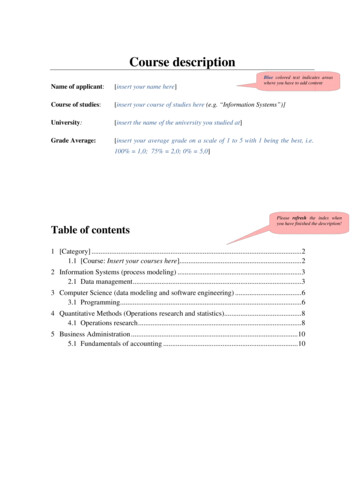
Transcription
Course descriptionBlue colored text indicates areaswhere you have to add contentName of applicant:[insert your name here]Course of studies:[insert your course of studies here (e.g. “Information Systems”)]University:[insert the name of the university you studied at]Grade Average:[insert your average grade on a scale of 1 to 5 with 1 being the best, i.e.100% 1,0; 75% 2,0; 0% 5,0]Table of contentsPlease refresh the index whenyou have finished the description!1 [Category] . 21.1 [Course: Insert your courses here]. 22 Information Systems (process modeling) . 32.1 Data management . 33 Computer Science (data modeling and software engineering) .63.1 Programming.64 Quantitative Methods (Operations research and statistics). 84.1 Operations research . 85 Business Administration . 105.1 Fundamentals of accounting . 10
Generic example of course descriptionPlease categorize your lectures into the following four categories: Information Systems, Computer Science, Quantitative Methods, and Business Administration1[Category]1.1[Course: Insert your courses here]StructureUse this structure as a template/ copy the boxes from theexample in order to addcourses in your document.Example (template):1. [headline/content of chapter one]1.1. [headline/content of first subchapter]1.2. [ ]2. [headline/content of chapter one]2.1. [ ]LiteratureExample (template): [Surname], [first letter of given name]. ; [Surname], [first letter of given name]. : [Title].[Subtitle]. [xth edition]., [place of publication] [year].Example (applied): Winskel, G.: The Formal Semantics of Programming Languages, 5th edition, Cambridge 2001.Additional InformationECTS:[insert the amount of ECTS concerning this lecture]Contact hours (semester periods per week): Lecture:[insert the amount contact hours spent for lecture] Tutorial:[insert the amount contact hours spent for tutorial] SUM:[Total amount of contact hours]
2Information Systems (process modeling)2.1Data managementStructure1. Conceptual data models by means of the entity-relationship-method1.1. Purpose of conceptual data models1.2. Basic elements within ERM1.3. Usage of cardinalities by means of the “Min-Max-notation”1.3.1. Syntax1.3.2. Combination possibilities and their interpretation1.4. Hierarchies and structures in an ERM1.4.1. Hierarchies and trees1.4.2. Structures and networks1.5. Attributes in an ERM1.5.1. Attributes as keys1.6. Multivalent relationship types1.7. Reinterpretation of relationship types1.8. Generalization and specialization in an ERM1.9. Special conventions of ER-modeling1.9.1. Denotation of relationship types1.9.2. The concept of “time” in an ER-model1.9.3. Conventions concerning cardinalities1.9.4. Conventions concerning generalization and specialization2. Transformation of ER-models into data base schemata2.1. Transformation of entity types2.2. Transformation of relationship types2.3. Transformation of generalizations and specializations2.3.1. Non disjunctive – partial2.3.2. Non disjunctive – total2.3.3. Disjunctive – total2.3.4. Disjunctive – partial2.3.5. Alternative transformation approachesThis is just an exemplarylecture of the Bachelor’sprogram at the WWU Münster.
3. Data base normalization3.1. First normal form3.1.1. Functional dependencies3.1.2. Procedure for transforming into first normal form3.2. Second normal form3.2.1. Procedure for transforming into second normal form3.3. Third normal form3.3.1. Procedure for transforming into third normal form3.4. Fourth normal form3.4.1. Multivalent dependencies3.5. Fifth normal form4. Structured Query Language (SQL)4.1. SQL as a standard4.2. Purposes4.3. Designators4.4. Values4.4.1. Character chains4.4.2. Numbers4.4.3. NULL-values4.5. Data types4.5.1. Numerical data types4.5.2. Time-related data types4.5.3. Character chain-related data types4.6. Creation of tables (CREATE TABLE)4.7. Modification of the table structure (ALTER TABLE)4.8. Removal of tables (DROP TABLE)4.9. Insertion of data (INSERT)4.9.1. Direct insertion4.9.2. Insertion from other tables4.10.Queries (SELECT)4.10.1. Simple queries4.10.2. Generation of preconditions (WHERE)4.10.3. Sorting (ORDER BY)4.10.4. JOIN-syntax4.10.5. Data aggregation4.10.6. Building of groups (GROUP BY)4.10.7. Conditions within groups (HAVING)4.10.8. The order of query processing4.10.9. Sub-queries4.11.Modification of data (UPDATE)4.12.Deletion of data (DELETE)
5. Data base synchronization and transactions5.1. Synchronization of data base processes5.2. Transactions (ACID)5.2.1. Atomicity5.2.2. Consistency5.2.3. Isolation5.2.4. Durability5.3. Anomalies with competing accesses to data5.3.1. Dirty read5.3.2. Lost update5.3.3. Non-repeatable read5.3.4. Phantom read5.4. Serializability of transactions5.4.1. Read-lock and write-lock5.4.2. Two-phase-protocol6. Dispositive data management systems – data warehouses6.1. Structure of a data warehouse6.2. Established data warehouse schemata6.3. Data warehouse model on function specification levelLiterature Becker, J.; Schütte, R.: Handelsinformationssysteme. 2nd Edition, Landsberg 2004. Vossen, G.: Datenmodelle, Datenbanksprachen und Datenbankmanagementsysteme. 5thEdition, Oldenbourg 2008. Scheer, A.-W.: ARIS, Modellierungsmethoden, Metamodelle, Anwendungen. 4th edition, Berlin 2001.Additional InformationECTS: 5Contact hours (semester periods per week): Lecture:2 Tutorial:2 SUM:4Please follow this example and add all lecturesrelated to the field of ‘Information Systems’ beforeyou continue with the second category: ‘ComputerScience’
33.1Computer Science (data modeling and software engineering)This is just an exemplary lecture of the Bachelor’s programat the WWU Münster.ProgrammingStructure1. Introduction1.1. Classification of programming languages1.2. Aims of programming2. Object-oriented programming (with Java)2.1. First java programs and features2.2. Basic types and operations2.3. Arrays2.4. Control structures2.5. Object orientation and programmingon large-scale2.6. Graphical user interfaces (GUI)2.7. Inner classes2.8. Exception handling2.9. Generic types2.10.Loops applied to collections2.11.Automated pack and upack2.12.Enumeration types2.13.Data files2.14.Value- vs. reference-semantics2.15.Java memory eral programming principles3. Declarative/functional programming (with Haskell/Curry)3.1. Definition of functions3.2. Definition of types3.3. Pattern-matching3.4. Type-inference3.5. Functions of a higher rank3.6. Lazy evaluation
3.7. Accumulation within parameters4. Semantics of imperative programming languages (by means of imperative language “IMP”)4.1. Syntax of IMP4.2. Reduction-semantics of IMP4.3. Machine-semantics of IMPLiteratureJava: Krüger, G.: Handbuch der Java-Programmierung, Studentenausgabe, München 2007.Haskell: Chakravarty. M.; Keller, G.: Einführung in die Programmierung mit Haskell, München2004. Thompson, S.: Haskell - The Craft of Functional Programming, 2nd edition, Harlow2003. Bird, R.: Introduction to Functional Programming using Haskell, 2nd edition, London1998.Semantics: Winskel, G.: The Formal Semantics of Programming Languages, 5th edition, Cambridge2001.Additional InformationECTS: 10Contact hours (semester periods per week): Lecture:4 Tutorial:2 SUM:6Please follow this example and add all lecturesrelated to the field of ‘Computer Science’ beforeyou continue with the second category: ‘Quantitative Methods’
4Quantitative Methods (Operations research and statistics)4.1Operations researchThis is just an exemplary lecture of theBachelor’s program atthe WWU Münster.Structure1. Graphs and trees1.1. Relations and graphs1.2. Shortest ways within graphs1.3. Trees1.4. Critical path analysis2. Linear optimization (linear programming)2.1. Basics (questions and solutions)2.2. Simplex algorithm2.3. Two-phase-method2.4. Sensitivity analysis2.5. Duality and the dual simplex algorithm3. Integer optimization3.1. Linear programming including integrity constraints3.2. Issues of transport3.3. Issues of allocation4. Decision optimization and Markov-chains4.1. Dynamic optimization4.2. Markov chains4.3. Markov decision processes5. Optimization procedures5.1. Problem classification5.2. Search procedures5.3. Simulated annealing5.4. Genetic algorithmsLiterature references Kathöfer, U.; Müller-Funk, U.: BWL-Crash-Kurs Operations Research, 2nd edition, Konstanz 2008. Bomze, I., Grossmann, W.: Optimierung- Theorie und Algorithmen. Eine Einführung inOperations Research für Wirtschaftsinformatiker, Mannheim 1993. Gal, T.: Grundlagen des Operations Research, Part 3, Berlin 1992. Neumann, K., Morlock, M.: Operations Research, 2nd edition, München 2002.
Additional InformationECTS: 10Contact hours (semester periods per week): Lecture:3 Tutorial:2 Additional qualification - computer supported mathematics:2 SUM:7Please follow this example and add all lecturesrelated to the field of ‘Quantitative Methods’ beforeyou continue with the second category: ‘BusinessAdministration’
5Business Administration5.1Fundamentals of accountingThis is just an exemplarylecture of the Bachelor’sprogram at the WWU Münster.Structure1. Purpose-orientation of accounting systems1.1. Subcategorization of economic accountancy1.2. Purposes of economic accountancy1.3. Definitions and demarcation2. Internal accountancy2.1. Tasks of cost-accounting/activity-accounting2.2. The structure of cost-accounting/activity-accounting2.3. Cost-accounting systems2.4. Cost-type accounting2.5. Cost-center accounting2.6. Cost-unit accounting2.7. Selective cost-accounting procedures3. External accountancy3.1. Basics of the annual account3.2. Reporting procedure3.3. Valuation3.4. Profit commission statement3.5. Additional elements concerning the accounts of stock corporations3.6. Annual audit3.7. Financial statement analysisLiterature Berens, W.; Flacke, K.; Kraft, M.; Triska, T.: Grundlagen des betriebswirtschaftlichenRechnngswesens, 3rd edition, Münster 2006. Coenenberg, A.: Kostenrechnung und Kostenanalyse, 5th edition, Stuttgart 2003. Baetge, J.; Kirch, H.-J.; Thiele, S.: Bilanzen, 8th edition, Düsseldorf 2005.
Additional InformationECTS: 10Contact hours (semester periods per week): Lecture:5 Tutorial:1 SUM:6Please follow this example and add all lecturesrelated to the field of ‘Business Administration’ inorder to finalize the course description.
6. Dispositive data management systems - data warehouses 6.1. Structure of a data warehouse 6.2. Established data warehouse schemata 6.3. Data warehouse model on function specification level ECTS: 5 Contact hours (semester periods per week): Lecture: 2 Tutorial: 2 SUM: 4

